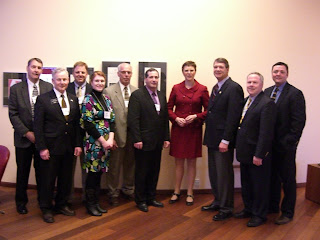Today in Denmark, we toured one of the BEST and MOST EFFICIENT power plants in the WORLD. DONG (Danish Oil and Natural Gas) Energy's Avedore Combined Heat and Power Plant is, in one word, impressive. The exterior was designed by an architect to be very appealing to the eye and as you pass through the heavy Viking-style copper door you enter a world of unprecedented technologies.

To see a video about the Avedore Power Plant, click
here, scroll down and click on the video. Pictures cannot do it justice, it is simply amazing.
 Safety first! North Dakota Attorney General Wayne Stenehjem and Agriculture Commissioner Doug Goehring prepare for the plant tour by donning hard hats and an earpiece so the tour guide could be heard as our group maneuvered through the plant.
Safety first! North Dakota Attorney General Wayne Stenehjem and Agriculture Commissioner Doug Goehring prepare for the plant tour by donning hard hats and an earpiece so the tour guide could be heard as our group maneuvered through the plant.  Here is a sample of the "wood chips" the plant was burning to produce power today.
Here is a sample of the "wood chips" the plant was burning to produce power today. Susanne Juhl (pronounced Susannah Yool), Deputy Permanent Secretary for National Energy and Climate, gave our group an overview of Danish energy policy. Here the elected officials in our group pose for a photo with Miss Juhl. From left, Representative Phillip Meuller, Senator Jim Dotzenrod, Senator Terry Wanzek, Jamestown Mayor Katie Anderson, Representative Dennis Johnson, Agriculture Commissioner Doug Goehring, Miss Juhl, Attorney General Wayne Stenehjem, Senator Tim Flakoll, and Representative Craig Headland.
Susanne Juhl (pronounced Susannah Yool), Deputy Permanent Secretary for National Energy and Climate, gave our group an overview of Danish energy policy. Here the elected officials in our group pose for a photo with Miss Juhl. From left, Representative Phillip Meuller, Senator Jim Dotzenrod, Senator Terry Wanzek, Jamestown Mayor Katie Anderson, Representative Dennis Johnson, Agriculture Commissioner Doug Goehring, Miss Juhl, Attorney General Wayne Stenehjem, Senator Tim Flakoll, and Representative Craig Headland.In her presentation, Miss Juhl made the statement that Denmark has "declared a state of energy independence."
My question to Americans, especially North Dakotans who read this: Can WE declare a state of energy independence as well, stop relying on foreign oil and start looking within our borders for the answers to our energy needs? I think we can.
I also think that some of the technologies I have seen these last few days may be part of the answer. Obviously, you can't just "copy and paste" what the Danish are doing and expect it to work in North Dakota, in a completely different political and economic system, but the question our group is trying to answer is "what pieces of the technology that the Danish have developed can be applied successfully in North Dakota"?
A few other fun facts about Danish energy policy:
- Denmark is the ONLY nation in the European Union that is a net energy exporter.
- There are 5,050 wind towers in Denmark.
- 17% of the energy generated from wind towers in Denmark is generated off shore (by wind towers in the ocean).
- The Danish utilize wind, straw, wood, biogas, waste (manure and food waste), and heat pumps as sources of energy.
- The Danish have set a goal of "fossil fuel independence" and have set forth to stop using oil by 2050.
- There currently is no tax on biomass because it is a fairly new source of energy. They will begin to tax biomass in 2020.
Here was my favorite part of today's tour: The fully automated crane that offloaded EIGHT large straw bales at a time (weighing MANY TONS) and stacked them on the conveyor system to be utilized in the power plant. Oh how I wish the baler/wagons I worked with as a kid had this feature :) I remember some really hot, muggy Maryland summers pulling small square bales out of the baler and stacking them on a flatbed wagon and then returning from the field and stacking them (again) in the barn . Built character...right? :)
Hope you enjoyed another virtual adventure in Denmark!
Sarah :)





























